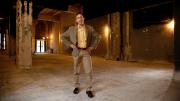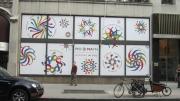A self-proclaimed numbers geek, Glen Whitney ’89 was so tired of hearing math labeled “boring” that he left his job as a hedge-fund quantitative analyst and created a $30-million math museum in New York City—the first of its kind in the United States, reports Bloomberg Businessweek.
“I started this museum because I wanted people to have a chance to see the beauty, excitement, and wonder of mathematics,” Whitney declared.
Opening on East 26th Street in 2012, the museum—called MoMath—won’t rely on old-fashioned displays of old calculators and slide rules; instead, the airy and colorful 19,000-square-foot space will offer hands-on, interactive exhibits that aim to bring mathematical concepts to life. Although the museum is aimed at children in grades 4 through 8, it will offer math experiences for all ages—one display features a hyper hyperboloid, a sculpture made of lines of red thread that create the illusion that the visitor is in a curved cage of strings; another, called "Pedal on the Petals," lets visitors ride square-wheeled tricycles on a track consisting of a series of curves shaped like a huge sunflower, reports Businessweek.
"Visitors can see—and physically experience—how math makes the seemingly impossible not only possible, but fun," Whitney told the Associated Press.
Whitney decided to create MoMath—with the help of a $2-million grant from Google towards his $30-million capital campaign—after the Goudreau Museum of Mathematics in Art and Science in Hyde Park, New York, closed several years ago. With so many New York State students struggling on their standardized exams, he saw the need for an engaging museum that would portray math as a fun and exciting subject, reports Education Update Online.
“We need to create a parallel culture of math, and parents and grandparents can start by engaging kids with math whenever possible,” Whitney urged in a Newsday op-ed last September. “Convey the wonder of some of the visible mathematical wonders in our world—the graceful curves of the Golden Gate or Verrazano bridges, the St. Louis Gateway Arch.”









